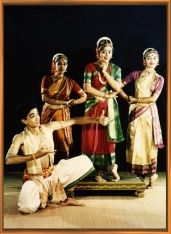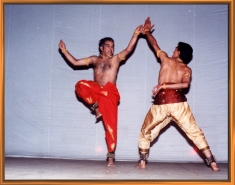

GROUP PRODUCTIONS
Raamanaatakam (Tamizh) (1976)
Raamanaatakam is the story of Rama through the compositions of Arunachala Kavirayar. Music by Turaiyur Rajagopala Sarma. It was done first in 1976, for the Tamizh Isai Sangam ‘Pann Aaraichi’ program. Raamanaatakam was presented at the Singapore Festival of Arts in 1984 and later in the USA and Canada in 1993.When Tamizh Isai Sangam asked the Dhananjayans to do a program using songs from Ramayana naatakam, they visualized a full dance drama, based totally on the Tamizh literature of Arunachala Kavirayar and taking the link scenes from Ramayana, made it a comprehensive whole running for a duration of 2 ½ hours.
The uniqueness of the production lies in the simplicity of its execution. The aharya abhinaya has been discarded and for such a grand subject, the epic story is presented with no props and neutral costumes for all characters, with emphasis on just body and facial expression. Hanuman and other characters are not dressed for representative characterization, but are instead portrayed only by the movements and expressions of the actors. Dhananjayan had been toying with this idea of using body line to project characters even from his Kalakshetra days but nobody had attempted such a thing. They were very apprehensive about how it would be received, but it was such a great success that they consider it one of their best productions to date.
The prowess of the dancers comes forth, each dancer sometimes portrays as many as 4 or 5 different characters, or different dancers do the role of Rama. In economically constructed scenes, the dance drama is in 5 sequences: Invocation to Lord Ranganatha of Srirangam; Sita Kalyanam; Manthara and Kaikeyi bringing about Rama's exile; The killing of Jatayu; Sethubandhanam, Battle and Coronation.
The highlight of this production is the building of the bridge across the ocean, which show the concern for time and space and always draws a spontaneous applause from the audience.
This made people realize that the idiom of Bharatanaatyam is so rich, that anything can be done, that there is no need for grand costumes, no paraphernalia on stage, no grand settings to denote a sea, bridge or battlefield. Raamanaatakam was indeed a big revelation to the dance world and it was performed all over India to critical acclaim. Many dancers took inspiration from that and presented their dance dramas, with simple Bharatanaatyam costumes.
Synopsis
The Ramayana is an epic story of India, steeped in mythology highlighting the eternal struggle between good and evil. Raamanaatakam is a selection of scenes set in the form of dance drama.
The opening scene is an invocation to the deity Sriranganathan at the Srirangam Temple. This is followed by the meeting of Sita and Rama. Rama wins a contest by breaking a bow to win the hand of Sita, and the scene ends in a wedding celebration.
But then a jealous hunchback named Manthara visits Kaikeyi, one of the queens of King Dasaratha, Rama’s father. She poisons Kaikeyi’s mind against Rama, and Kaikeyi agrees to persuade Dasaratha to give the throne to Bharatha, Rama’s brother. Dasaratha accedes to her request, but he is heartbroken. Rama is exiled to the forest.
While in the forest, Sita is abducted by Ravana, the king of Lanka, who slays the great bird Jatayu who attempts to rescue her. With the help of the Monkey God, Hanuman, and his army, Rama builds a great bridge across the ocean: there is a mighty battle, in which Ravana is killed. Finally, Rama returns to Ayodhya with Sita and is crowned.
"In 1976 itself, we have used the body so well, each character had a particular stance, so the minute the person entered the stage, the audience could immediately recognize the character portrayed, be it Hanuman, Dasaratha or Ravana. We did not have many male dancers in the company then, so I actually did 4 roles! Thus, Raamanaatakam had the drama element as well as emoting through body line."
"For the Sethubandanam, a whole bridge was created by the human bodies. In those days, people could not visualize how such a thing could be done in Bharatanaatyam. I had not thought of introducing the little squirrel who is supposed to have helped Rama, since the production did not warrant it. Suddenly, during the rehearsal, a squirrel fell into the studio. I felt Rama was sending me a message of the little creature’s service to him. So, I made my niece play the role. My son Sanjay adopted the squirrel and called it Ram. Though it was an insignificant role, that scene always drew the most applause.
"In Rama Ravana yuddham, only 2 people were involved instead of a customary group for the battle scene. Arunachala Kavirayar has written a beautiful descriptive piece and Rajagopala Sarma set the music in such a way that the whole battle scene can be portrayed with only 2 characters. I proved in 1976 that one could make a minimalist presentation of a traditional grandiose theme. I made it more elaborate later on by using Tulsidas’ Ramayan, Ezhuttachan’s Malayalam work… the same thing made more accessible to a wider audience and we called it Sita Rama Katha."
"In a performance of Raamanaatakam in Delhi, I did the roles of both Dasaratha and Manthara. Subbudu criticised me, that a robust, male dancer imitating an old lady like Manthara was absolutely gross. When I met him face to face, I asked Subbudu, "Maama, you are a stage actor. If a man can evoke the rasanubhuti in you as the old, crooked Manthara, that itself is a compliment and not at all detrimental to the character". After a little contemplation, Subbudu agreed with my reasoning."
This is just one such interesting encounter between dancer and critic!!
Unfortunately, after returning from our first performance, we found that the squirrel had died, almost as if it’s mission was over"
RAAMANAATAKAM - Reviews - Photo Album
